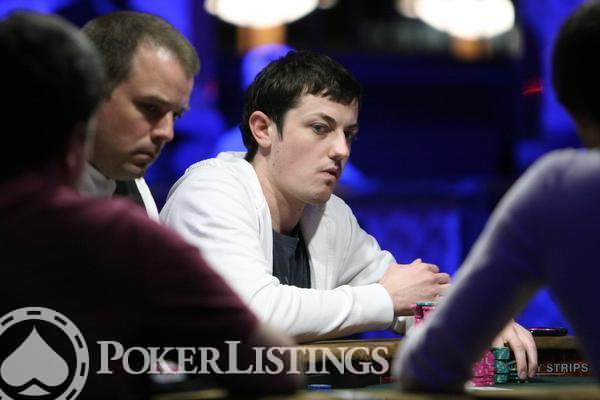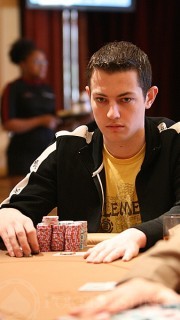Dwan vs. Eastgate: Best WTF Look Ever on High Stakes Poker?


- Fact Checked by: PokerListings
- Last updated on: September 19, 2024 · 10 minutes to read
Last Sunday, High Stakes Poker stormed back onto television screens nationwide with one of the most talked-about hands in its history.
The highlight of the first episode of the fifth season was clearly the $175,200 pot played between WSOP Main Event Champion Peter Eastgate and online dynamo Tom “durrrr” Dwan.
The hand, probably one of the most thought-provoking ones ever played on the show, had people arguing whether Eastgate missed out on value by playing the hand so passively.
Although with stacks $500,000+ deep, is a raise just a Pandora’s box better left closed? Here’s how it played out.
Players:
- Tom Dwan
- Daniel Negreanu
- Barry Greenstein
- Illari Sahames
- Peter Eastgate
- Doyle Brunson
- Eli Elezra
Game: High Stakes Poker Season 5, $400/$800 blinds with a $200 ante
Eastgate vs. Durrrr on High Stakes Poker
The hand begins with Elezra folding under the gun. Ilari’s cards are next to hit the muck, followed quickly by Daniel’s.
Eastgate opens the pot from the cut-off to $2,500, and Brunson calls on the button. Greenstein calls out of the small blind and durrrr calls from the big blind.
The flop comes 6♦ 5♥ 3♦. Greenstein checks, and durrrr leads for $7,700. Eastgate makes the call; Doyle and Greenstein fold.
The turn comes the 6♠. durrrr bets $20,200 into $27,000. Eastgate once again just flat-calls, and the river comes K♠.
Durrrr bets out again – $53,9000 into $67,400. Eastgate thinks for a moment before calling.
Durrrr calls out 6-7 for three of a kind with seven kicker, and Eastgate sheepishly turns over A♥ 6♥ for three-of-a-kind sixes, better kicker.
Eastgate’s A♥ 6♥ is good for the $175,200 pot, and durrrr is left with a wtf? look on his face.
The Breakdown
Let’s start out by determining the players’ stack sizes. So much of this hand and of poker hands in general boils down to stack sizes.

In the episode they never actually say what either player’s stack size is, and without that vital piece of information, there’s virtually no reason to even discuss a hand – it’s impossible.
The hand in question is on YouTube, though. I watched it several times over and figured out the chip denominations and ultimate stack-size estimates.
If you pause at 25 seconds you can see Eastgate’s entire stack. It consists of a $100,000 brick of cash, 12 blue $25,000 chips, 20 white $5,000 chips, 32 cranberryish $1,000 chips and 30ish pink $500 chips.
That totals around $550,000, and from what it looks like, durrrr easily covers him, so we can place the effective stacks at around $500,000 ish or 600BB, or in layman’s terms, really effing deep.
OK; on to the hand.
It’s folded around to Eastgate, who raises to $2,500 in the cut-off with A♥ 6♥. They’re playing seven-handed, and with $2,600 in the pot a suited ace seems like more than enough to make a steal-raise.
However, with so much money in the pot already, a bigger raise amount would be better – especially when everyone is playing so deep.
Doyle calls on the button with A♦ J♠. He’s got a good ace and decides to see a flop in position, a perfectly fine play. Greenstein is drawn in by the rapidly growing pot odds, and calls with the J♣ T♣ in the small blind.
durrrr, in the big blind, has to call $1,700 more to see a flop. With $9,000ish in the pot already he makes a pretty easy call with 6♣ 7♣, getting like a million to one.Get Up to $500 Now!
Appeak Poker
T&Cs Apply | Play Responsibly | GambleAware
T&Cs Apply | Play Responsibly | GambleAware
The Flop
The flop comes 6♦ 5♥ 3♦ and Greenstein checks after missing the flop completely.
durrrr elects to donk-bet $7,700 in to the $11,600. He has top pair with a gut-shot and very likely has the best hand right now.
Eastgate makes the call. He has top pair, top kicker. His hand is good, but it’s nowhere near strong enough for a raise at this point.
He has two good players behind him, both of whom are capable of slow-playing big hands. Thus he elects to flat-call to see what happens.
The Turn
Both Doyle and Greenstein fold, and Eastgate and durrrr see the 6♠ turn heads-up. If there was any doubt in durrrr’s mind that he had the best hand on the flop, it’s removed now that he trips up on the turn.
He leads for $20,200 for value. At this point he is likely putting his opponent on an overpair like 88-AA, or a flush or straight draw.
Eastgate elects to just call, which is an interesting play. Now the knee-jerk reaction would be to raise. Something like “Hurrr, I has three of a kind, awwrr in.”
However, is that the best idea? Obviously shoving would be bad, but what about some type of value raise? It all boils down to what durrrr’s range is. So let’s take a look at it.
Before the flop he called a raise in the big blind, getting 9-1 with 500BB stacks. He would do this with a very, very wide range. When the flop comes down he leads into three people, and we can start to put him on a more accurate range.
It’s something like nonset pocket pairs 88, 77, 44 (possibly 99 and up, but there is a good chance he squeezes those in a multiway pot), set-making pocket pairs 66, 55, 33, two-pair hands 6-5, 5-3, pair and straight draws 6-7, 5-7, maybe even 3-7s, flush draws and straight draws and the flopped straights 2-4 or 4-7.
You can also probably add some random weird bluffs, which are possible although somewhat discounted because, generally, bluffing into three people is bad.
Tl;DR still very wide.
Once Eastgate calls and the turn comes a 6♠, we can start to narrow durrrr’s range a little, but not a lot. He’d probably now check his non-full house pocket pairs and his 5-3, as his two pair would be counterfeited.

That leaves full houses, pair and straight draws, random sixes, possible naked straight and flush draws and obviously his flopped straights. Something like 33, 55, 6-5, 9-6, 6-8, 6-7, 6-4, 9-6, A-6, 77, 7-8 and random flush draws.
Now Eastgate’s A♥ 6♥ is clearly ahead of the bulk of that range. But does that automatically mean he should raise it?
To figure that out we need to believe durrrr would call with worse. So let’s think about what types of hands are in durrrr’s calling range.
This is where it gets even more complicated. To find out what durrrr’s calling range is, you have to think about what Eastgate’s turn value-raising range is.
At first it seems like he would value-raise overpairs, something like AA-88 – although you’d have to assume that Eastgate either raises the flop or just flat-calls the turn with them.
When you look deeper there is very little value in raising overpairs on the turn, so those must be discounted. After all, what hands worse than overpairs would durrrr call with on the turn?
Pretty much only the draws; everything else that durrrr calls a turn raise with absolutely crushes any pocket pair.
So Eastgate would be better off just calling a turn bet and possibly allowing durrrr to fire again if he believes durrrr has a draw.
Basically, if Eastgate raises the turn, he reps a very narrow range. Something like full houses, three of a kinds and your occasional semibluffed draw.
These two players do not have enough history for Eastgate to raise the turn with a pair and expect to be looked up by worse. (Yes, they’ve played online since this hand, but hadn’t much before it took place.)
For durrrr to actually call a raise on the turn with worse than A-6 he would have to believe that Eastgate is either value-raising worse than 6-5 or bluff-raising a high percentage of the time.
Which means if Eastgate raises the turn, durrrr’s calling range is sixes, full houses and possibly his draws, and he would fold everything else. Which might seem fine, but it also opens the door to be reraised, and this deep, that would be a pretty horrible situation. Thus he chooses to just call.
Furthermore, should durrrr call a raise on the turn, to think that he would call another river bet is just foolish. There is literally not a hand in the world that Eastgate value-raises the turn and then fires the river with that durrrr could beat.

Thus the river action would almost certainly go check-fold or check-check, netting Eastgate almost the exact same as if he flats the turn and flats the river.
The plus side to just flatting the turn is he may get durrrr to bluff the river with the missed draw portion of his range.
The River
The river comes down K♠. durrrr fires $53,900 into $67,400, and Eastgate once again chooses to just call.
durrrr fires the river for what he believes is value. He puts Eastgate on a pocket pair and he wants to value-town it hard. He doesn’t expect his opponent to fold; he’s likely thinking that this pot is his and is just waiting for Eastgate to call.
Eastgate has the best hand now, like he has had the whole hand. However, for the same reason as on the turn, he feels that there is little value in raising.
durrrr fired near pot on all three streets. His range is very polarized: he either has a great hand, meaning at least three of a kind, or he has a bluff. Of those, a bluff is obviously never going to pay off a raise.
But do the three sixes of his range pay off a raise? Maybe. After the hand durrrr said he would have obviously paid off a raise; however, I’m not sure if he was telling the whole truth.
After all, like I said, on the turn for there to be value in raising the river, durrrr has to be capable of calling with worse.
For durrrr to call with worse, he would have to expect Eastgate to value-raise with worse than 6-7, which is a bit dubious to expect. Lastly, because they are so deep, raising either the turn or the river reopens the betting for durrrr to possibly reraise with the top of his range.
Simply put, facing a large bet-raise-reraise when you are 600BB deep would be a pretty s**tty situation to deal with. So Eastgate elects to flat-call on the river and durrrr shoots him a look of wtf are you doing.
Now I can’t tell whether that is put on or what, but looking at the hand deeper, it’s hard to believe that durrrr does put any more money into the pot than he already did.
Sure; he probably calls a turn raise, but faced with a turn raise and a river bet with triples, no kicker doesn’t quite look so hot.
He may even find a fold, in which case Eastgate would make the exact same as flatting the turn and river. And by flatting he avoids the whole “going broke with triples best kicker in a 1,200BB pot on national television” that is entirely possible looking at durrrr’s range.
Overall, I think this hand isn’t quite as bad as it first looks. The stacks are incredibly deep and durrrr is an extremely tricky player. Though many will argue that Eastgate may have missed out on some value, I think we can all agree that it’s pretty awesome that they decided to bring back HSP.
-
Stake.US Poker4.3
- Rakeback 5%
- $55 Stake Cash + 260K Gold Coins
T&Cs Apply | Play Responsibly | GambleAware
18+ | Play Responsibly | T&C Apply
-
Appeak Poker4.1
- 1,000 Chips Daily
- FREE 5,000 Chips
T&Cs Apply | Play Responsibly | GambleAware
T&Cs Apply | Play Responsibly | GambleAware
-
- 2,500 Gold Coins + 0.50 Sweeps Coins
T&Cs Apply | Play Responsibly | GambleAware
18+ | Play Responsibly | T&C Apply
-
- 150% up to 25 SC
T&Cs Apply | Play Responsibly | GambleAware
Terms & Conditions apply
-
- 5%
- 200% Gold on 1st Purchase
T&Cs Apply | Play Responsibly | GambleAware
Terms & Conditions apply

User Comments
There may be some slight value in raising the river, but in my opinion it is very little if any. If Peter can put Tom on his exact hand (a 6 with weaker kicker) then yes, there is obviously value in raising. The problem is that 6 worse kicker is such a small portion of his range and if we look at his possible holdings (pocket pairs 3´s through Jacks´s, 4/7, 5/6,6/3) then the only hands that Tom would even consider calling a river raise here would be with 6 worse kicker.
By re raising the river Peter folds out all one over/ under pair type hands, bluffs, etc. while opening himself up to be crushed by the majority of Toms other possible holdings consisting of straights and full houses.
So unless Peter can put Durr on his EXACT hand by raising the river he is only folding out hands that he dominates and is ony getting called or re raised by hands that have him crushed.
I think Peter played the river well although I can see raising the turn to fold out possible straight and flush draws that Tom may have double barreled with but when he fires the third river barrel Its a different story.
Well Durrr’s face is really annoying here…
I don’t think he made it like honestly, he just wanted to push Peter out of his comfort zone, and he done it with a lot of disrespect…. That face was more like: ”you got lucky to win main event, and i play so much better than you!” then face: ”you played bad this hand”
I wonder what kind of face he would make if Doyle Brunson made that call? And it is very possible that Doyle would play the hand the same way….
He would knock the table and said nice hand, most probably….
i agree, i can’t see how raising the river here will achieve anything for Eastgate except potentially get himto throw away the best hand if Dwan re-raises him.
Say P.E. raises him, Dwan’s can not call that bet and win the pot. Dwan knows that. With four people in the pot you can 95% rule out bluff’s, even though it’s head up by the river, it’s still unlikely.
So if PE raises, Dwan will know he is not doing it with anything worse than trips, and Dwan has basically the worst three-of-a-kind, so he’ll either fold (“He has a better hand and I don’t think I can get him off”) or he’ll re-raise (“I’m going to rep a full house here with pocket 5’s or 3’s”)…
Furthermore to that we know Dwan is aggressive and calling is not in his nature, which further pushes us into the fold or re-raise territory.
Now if Dwan folds Eastgate’s raise achieves the same as calling. Actually achieves less because he was able to see Dwan’s cards and how he played the hand…
If Dwan re-raises that puts Eastgate in a really really really tough position. One in which he just might throw away the best hand believing Dwan to have a full house.